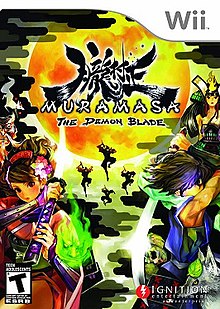| Muramasa: The Demon Blade | |
|---|---|
 North American Wii cover art | |
| Developer(s) | Vanillaware |
| Publisher(s) |
|
| Director(s) | George Kamitani |
| Producer(s) | Yoshifumi Hashimoto |
| Programmer(s) | Kentaro Ohnishi |
| Artist(s) | Yasuhiro Fujiwara
|
| Writer(s) | George Kamitani |
| Composer(s) |
|
| Platform(s) | Wii, PlayStation Vita |
| Release | |
| Genre(s) | Action role-playing |
| Mode(s) | Single-player |
Muramasa: The Demon Blade[a] is a 2009 action role-playing game developed by Vanillaware and published for the Wii by Marvelous Entertainment (Japan), Ignition Entertainment (North America), and Rising Star Games (Europe). An expanded PlayStation Vita version was published in 2013 by Marvelous AQL in Japan and Aksys Games in Western territories. Using a 2D side-scrolling perspective, the gameplay revolves around a beat 'em up fighting system, while incorporating role-playing elements such as leveling and questing.
Muramasa takes place during the Edo period on Japan's main island of Honshu during the reign of shogun Tokugawa Tsunayoshi. Conflicts have arisen over ownership of the Demon Blades, samurai swords forged by Muramasa Sengo that bring tragedy and madness upon their wielders. The story revolves around two protagonists related to this conflict: Momohime, a woman who is possessed by the spirit of vengeful rōnin Jinkuro Izuna; and Kisuke, an amnesiac ninja on the run for a forgotten crime who is tied up with the tragedy that destroyed Momohime's family. The Vita port includes four self-contained stories based on Japanese folklore released as downloadable content.
The concept work for Muramasa began during the middle of development on Odin Sphere. Along with improving on the action gameplay over Odin Sphere, a great deal of effort was put into making the game's setting authentic to the period. Director and writer George Kamitani created the story based on kabuki theatre, incorporating Japanese folklore and Buddhist theology. When the game was released in the West, it retained its Japanese voicetrack to preserve its atmosphere. It was released to moderate sales and positive reviews. The Vita port, released in the West as Muramasa Rebirth, had strong sales and similar reception to its original version.
Cite error: There are <ref group=lower-alpha> tags or {{efn}} templates on this page, but the references will not show without a {{reflist|group=lower-alpha}} template or {{notelist}} template (see the help page).